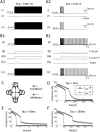A robust in vivo-like persistent firing supported by a hybrid of intracellular and synaptic mechanisms
- PMID: 25901969
- PMCID: PMC4406621
- DOI: 10.1371/journal.pone.0123799
A robust in vivo-like persistent firing supported by a hybrid of intracellular and synaptic mechanisms
Erratum in
-
Correction: a robust in vivo-like persistent firing supported by a hybrid of intracellular and synaptic mechanisms.PLoS One. 2015 Jun 3;10(6):e0130237. doi: 10.1371/journal.pone.0130237. eCollection 2015. PLoS One. 2015. PMID: 26039565 Free PMC article. No abstract available.
Abstract
Persistent firing is believed to support short-term information retention in the brain. Established hypotheses make use of the recurrent synaptic connectivity to support persistent firing. However, this mechanism is known to suffer from a lack of robustness. On the other hand, persistent firing can be supported by an intrinsic cellular mechanism in multiple brain areas. However, the consequences of having both the intrinsic and the synaptic mechanisms (a hybrid model) on persistent firing remain largely unknown. The goal of this study is to investigate whether a hybrid neural network model with these two mechanisms has advantages over a conventional recurrent network based model. Our computer simulations were based on in vitro recordings obtained from hippocampal CA3 pyramidal cells under cholinergic receptor activation. Calcium activated non-specific cationic (CAN) current supported persistent firing in the Hodgkin-Huxley style cellular models. Our results suggest that the hybrid model supports persistent firing within a physiological frequency range over a wide range of different parameters, eliminating parameter sensitivity issues generally recognized in network based persistent firing. In addition, persistent firing in the hybrid model is substantially more robust against distracting inputs, can coexist with theta frequency oscillations, and supports pattern completion.
Conflict of interest statement
Figures







References
-
- McEchron MD, Weible AP, Disterhoft JF. Aging and learning-specific changes in single-neuron activity in CA1 hippocampus during rabbit trace eyeblink conditioning. J Neurophysiol. 2001;86: 1839–1857. - PubMed
-
- Schon K, Hasselmo ME, LoPresti ML, Tricarico MD, Stern CE. Persistence of parahippocampal representation in the absence of stimulus input enhances long-term encoding: a functional magnetic resonance imaging study of subsequent memory after a delayed match-to-sample task. J Neurosci. 2004;24: 11088–11097. - PMC - PubMed
Publication types
MeSH terms
Substances
LinkOut - more resources
Full Text Sources
Other Literature Sources
Miscellaneous

